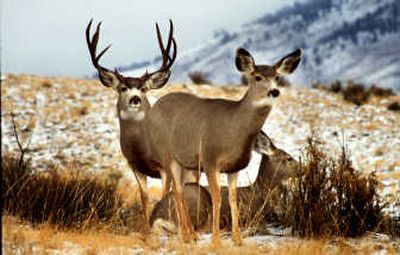Pilot project indicates flaws

Grazing on state wildlife lands has become a hot-button issue in Washington with little middle ground. People either want it and see benefits to wildlife habitat and to the rural economy, or they consider it a travesty.
A pilot program that started with limited livestock grazing on the Asotin Creek area in southeastern Washington, germinated from a 2005 meeting Gov. Chris Gregoire had with the Washington Cattlemen Association.
Already hit hard by mad cow hysteria and a statewide cutback in packing-plant capacity, the latter being a financial nightmare for the entire industry, the cattlemen asked Gregoire for increased grazing opportunities on state lands.
Gregoire told the Washington Department of Fish and Wildlife to set up the pilot program, which is scheduled to expand this year.
Pro-grazing rangeland specialists say carefully planned, well-monitored cattle grazing can remove dry and decadent forage, leaving behind the kind of “quality forage” that will keep deer and elk on those state lands and prevent them from wreaking havoc on private property.
Anti-grazing conservationists argue that cattle harm wildlife habitat, congregating in and along creeks where they destroy fish spawning areas and increase erosion. They have photographs to support their point taken during the state’s initial grazing pilot project in Asotin County.
“There’s truth on both sides, and what we’re trying to do is find that place in the middle where we can minimize the bad and maximize the good,” said Ed Bracken, WDFW rangeland specialist. “It’s not a black and white issue.”
Wildlife managers and livestock ranchers have a symbiotic relationship. Their lands are often adjacent. Indeed, many of the state-managed wildlife lands formerly belonged to ranchers.
While livestock have been allowed to graze on public wildlife lands, wildlife also regularly turn to the greener irrigated fields on private lands.
Wildlife managers want the ranching community as a satisfied neighbor. They want hunters to be welcomed – or at least tolerated – on those ranchlands, and having ranches as neighbors is better than subdivisions and grocery stores.
“We’ve been trying to improve relations with the farming and ranching community in general,” said Jerry Gutzwiler, chairman of the Washington Fish and Wildlife Commission. “A lot of it has to do with trends we’re seeing in terms of development.
“Anything is better for us than having those lands carved up into little pieces and having people living on them.”
But wildlife managers and habitat specialists also look back at the destructive overgrazing of years past, and fear a repeat. Many of them have spoken extensively off the record about their reservations about cattle grazing on wildlife land, but are unwilling to be quoted.
As one said, “We all know this is political.”
Results from the initial phase of the pilot project tend to support the fears.
“It didn’t go well,” said former state wildlife commissioner Bob Tuck, referring to last spring’s pilot grazing on the Asotin Wildlife Area.
An Idaho-based conservation group, the Western Watersheds Project, has sued the state wildlife department over the project.
One rancher put out nearly twice as many head of cattle as were permitted, and photographs sent to media outlets and legislators painted an ugly picture of a pilot program that seemed to be crashing.
“All the things (wildlife and cattlemen representatives) promised wouldn’t happen are the very things that did happen,” Tuck said.
“They promised the cows wouldn’t be in riparian zones (areas near rivers and streams), and they were in the riparian zones with ESA (Endangered Species Act)-listed fish. They promised the cows would be kept out of sensitive areas like springs and seeps, and they were in springs and seeps on very steep slopes, and making real mud holes with them. They talked about even distribution of the grazing, and yet they didn’t get even distribution.”
Jack Field, executive vice president of the Washington Cattlemen’s Association, said the Asotin grazing experience was an eye-opener – and a lesson learned.
“The biggest thing we’ve found in the Asotin is the need for flexibility,” Field said last fall in a wildlife land and grazing forum in Yakima.
“Folks thought they would only have to be riding out there every few days, and they’re finding out they need to be out there every day from dawn to dusk,” he said. “We need to make sure we’re putting out the best image we can on the kind of stewardship we have.”
Done properly, grazing can help wildlife, experts say.
Grazing presents a “disturbance of the ecosystem,” said Kevin Guinn of the U.S. Department of Agriculture’s Natural Resources Conservation Service. “But many portions of the ecosystem require some sort of disturbance to thrive.”
The key, Guinn said, is all in management and monitoring.
“I think there’s a place for grazing, but it’s very minimal,” said one wildlife area manager who asked to remain anonymous. “Grazing can be done on a one-year basis – get them on, get them out of there, and you’re done.”
However, the grazing program is looking at a longer-term relationship, but not necessarily in all the right places.
“There’s nothing in the (pilot project) grazing plan and monitoring plan about monitoring the riparian and stream condition,” said Don Johnson, a resident of the Methow Valley and member of Western Watersheds Project, who says he has degrees in conservation, zoology and fish ecology.
“It’s all about the vegetation. It’s all about the cows.”